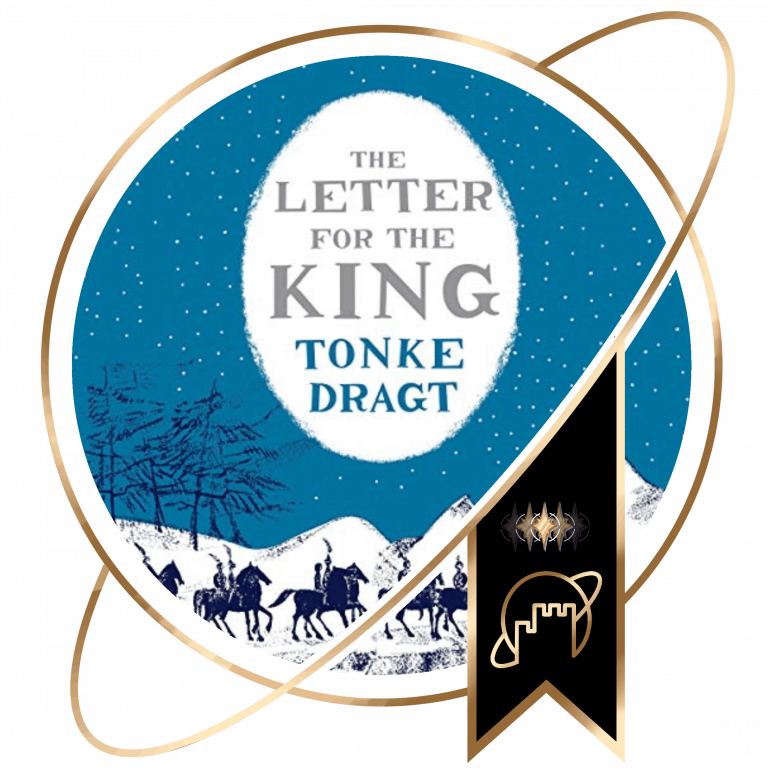April 16, 2022

Collected on: April 16, 2022
- Book written by Tonke Dragt
- Published in 1962
- Followed by The Secrets of the Wild Wood
On the night before he will receive his knighthood, the young squire Tiuri leaves the chapel of his nightly vigil to answer the call of a stranger asking for help from the dark outside. What initially seems a simple task ends up leading him in a dangerous quest across mountains and kingdoms with pusuers on his tale every step of the way.

Welcome to this in-depth, spoiler-free discussion of The Letter for the King (Brief voor de Koning) by Tonke Dragt, the masterpiece of Dutch children’s fantasy fiction (and not, mind you, the awful Netflix series), which our curators Peter and Jasmijn are adding to the Escape Velocity Collection, a series of items that we believe represent the absolute peak of what the speculative genre has to offer.
It turns out we don’t have any curator who doesn’t absolutely adore The Letter for the King, so we’re deviating from our format a little bit (we couldn’t find anyone critical enough), so instead, Jasmijn (who’s a primary educator) and Peter (who’s a stuffy old lawyer) are going to talk about why this is a great book for both children and adults! So in short, we’re going to add The Letter for the King to the collection together – and tell you why the next thing you should read is the Tonke Dragt’s magnum opus.
So, to start off – when did you first read The Letter for the King and what did it do to you?
I love this question, because The Letter for the King has won a special place in my heart at a relatively young age. When I was nine this book was the very first big chapter book I read. It was, for me, the gateway to the magic of real stories. I was completely sucked into the story and the adventure of main character Tiuri. After that, I was never to be found without a book.
How about you? How did you get introduced to this timeless classic?
I’m honestly not entirely sure, but given that I read The Lord of the Rings by the time I was nine (I know, why???), it must’ve been at least a couple of years before that. I remember my dad reading the first chapter about Tiuri’s nightly vigil on the cold stone floor of the chapel and falling in love instantly with this story that epitomised everything that I felt a medieval story ought to have. I already loved visiting castles and old towns with my parents, I owned a plastic sword and my mum embroidered a dragon on a surcoat for me. But when my dad started reading The Letter for the King, there really was no turning back: that was the moment my parents doomed me, the first action in a chain of events that eventually led to me becoming a fantasy nerd who writes reviews of fantasy books for a hobby and does H.E.M.A. (historical fencing) for a sport. Tonke Dragt started it all!
Let’s dive in her world and see what that magical book is all about.
Worldbuilding
There’s no two ways about it, the world of The Letter for the King is not particularly original. The story takes place over two medieval European Kingdoms, one with a slightly more north-western European feel, one with a slightly more southern European feel (though some of that distinction may be my imagination). Perhaps the most interesting element is that the characters appear to be Christians, though it doesn’t play a significant role in the story.
At the same time though, I found re-reading the book to be surprisingly refreshing. Sometimes, it feels like the trend in modern fantasy is to go for a dark, more ‘realistic’ world full of long history, complex politics, intriguing magic systems, violence, and a very steep learning curve. The Letter for the King is the antithesis of all that. It presents an unabashedly simple noblebright world of knights and squires, damsels and castles. Even bandit chieftains have honour. A single betrayal in a duel can spark the plot of two whole books.
If all the fantasy in the world were like this, it would get boring. But as it stands, The Letter for the King is an amazing palette cleanser.
For a child who has never read a fantasy book, though…
I feel like you are almost touching upon an excellent point here. As media-devouring adults, we quickly look down upon classic stories, calling them clichés and such. But when you are young, every new genre is a completely new concept. This is why well-written classics like The Letter for the King are important. They are the backdrop for our future story-adventures. The way in which Tonke Dragt has written this knight’s tale is elegant and quick-paced. The story is exciting, especially when you are younger, because you don’t know yet about fantasy tropes.
Also, I have to add that I would have never even considered this book to be eligible for the fantasy genre. Which is probably why it is a perfect gateway to books that are more high-fantasy. The medieval setting creates a familiar starting point since even young children have some basic knowledge of the world of knights and castles. Which is definitely not always the case when we move into the sci-fi realm.
Characters
This book is considered a great read for twelve-year olds. However, one of the reasons it is still a comfortable read for adults is the ways in which our main characters is usually not an idiot. I have read/watched my fair share of children’s media, and ‘teenagers making stupid choices’ is something that can get on my nerves quite quickly (looking at you, Shannara chronicles). Tiuri doesn’t always make the right choice, but he does seem to understand the urgency of his task.
I agree, I love that Tiuri is allowed to make mistakes – and has to persevere through some hardships – without adversity becoming the core of his character.
My own favoured character is Sir Ristridin of the South, whom I like to call ‘’the Dutch Aragorn”, the noble and wise questing knight with his silver horn, wandering the land looking for vengeance and adventure. Ristridin is a classic character played straight (he would not look out of place at King Arthur’s court at Camelot), but one which drew me in and inspired me like no other when I read about him as a kid. Perhaps it is because the book is a little bit older, but I love that Dragt felt at liberty to just write a character that is the pinnacle of the knightly ideal in a kid’s mind, with no caveats or subverted expectations. It is great for kids but even as an adult, it just fills your heart with joy and, for me, a certain nostalgia to simpler stories, where the good guys were good and the bad guys bad.
Age
A I said, The Letter for the King is a bit on the older side: it was published in 1962. Obviously, the book’s age is not going to play as much of a part for more grown up readers as it will for children, and I think that apart from an odd choice of word here or there, there is very little holding it back for modern readers (besides, that shouldn’t be a problem if you’re reading in translation). There’s the odd christianity reference that seems a bit out of place in modern fantasy, but they are few and far between – and I think they fit well with the world that is relatively closely based on medieval Europe. So the real question is – do you think that also goes for today’s children?
Of course, this book will not be a good fit for all children, in the same way adults have their preferences in literature. It is most definitely not considered an easy read for kids. In general, I would recommend the book to readers age 12 and up. Since the story is set in medieval times, it seems like kids accept the archaic language more easily. But the book was written with the younger audience in mind. Language that is specific for the medieval setting, is usually explained in the context of the story. As a primary school teacher, one of my goals is to find ways to bring new and fitting books to the attention of my pupils. Re-reading this book I was surprised by the bite-sized chapters, which makes it a perfect read-aloud. The biggest tell this book is old? All cool main characters are male: maybe when reading to your kids genderbend a character, or two.
Conclusion
Whether you are looking for a gift for yourself or for someone else, a story for fantasy newbies or sci-fi nerds, or a book to read out loud in your classroom: you have found it. The Letter for the King is most definitely a classic for a broad target audience. Translated in more than 30 languages, you might even be able to find it in your mother tongue, or in a language you are learning. Just don’t watch the series (you can find our review on that HERE).








